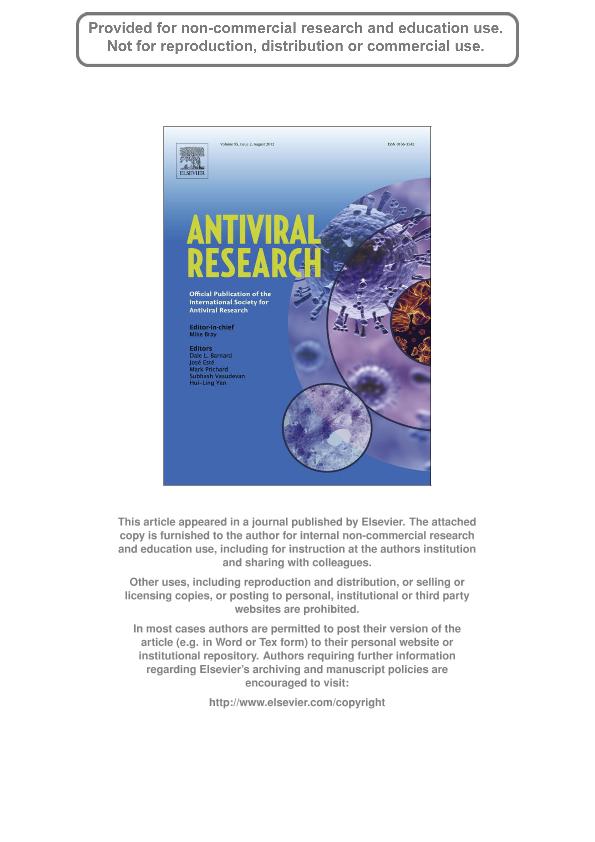Artículo
Longitudinal analysis of the 5'UTR, E2-PePHD and NS5A-PKRBD genomic regions of hepatitis C virus genotype 1a in association with the response to peginterferon and ribavirin therapy in HIV-coinfected patients
Bolcic, Federico Martin ; Laufer, Natalia Lorna
; Laufer, Natalia Lorna ; Torres, Carolina
; Torres, Carolina ; Cassino, Lucila
; Cassino, Lucila ; Reynoso, Rita Paola
; Reynoso, Rita Paola ; Quarleri, Jorge Fabian
; Quarleri, Jorge Fabian
 ; Laufer, Natalia Lorna
; Laufer, Natalia Lorna ; Torres, Carolina
; Torres, Carolina ; Cassino, Lucila
; Cassino, Lucila ; Reynoso, Rita Paola
; Reynoso, Rita Paola ; Quarleri, Jorge Fabian
; Quarleri, Jorge Fabian
Fecha de publicación:
08/2012
Editorial:
Elsevier Science
Revista:
Antiviral Research
ISSN:
0166-3542
Idioma:
Inglés
Tipo de recurso:
Artículo publicado
Clasificación temática:
Resumen
Background: The rate of non-response to pegylated interferon plus ribavirin (peg-IFN. +. RBV) in HCV/HIV coinfected patients is higher than in HCV-monoinfected patients. In this sense, the contribution of HCV genetic variability is unknown. The 5' untranslated (5'UTR), the nonstructural 5A (NS5A) and the second envelope (E2) HCV genomic regions have been implicated to peg-IFN therapy response. The proteins appear to block interferon (IFN)-induced RNA-dependent protein kinase (PKR) and the 5'UTR may influence the viral lymphotropism. Methods: We examined comparatively the pretreatment HCV variability between HIV coinfected and HCV monoinfected patients as well as assessed longitudinally the impact of peg-IFN. +. RBV on HCV variability when HIV is co-present. For this purpose, 15 HIV coinfected and 20 HCV monoinfected patients were compared. They were peg-IFN. +. RBV non-responders and infected with HCV 1a. Results: Irrespectively of the HIV-coexistence, at baseline the amino acid variation in the NS5A-related domains was significantly higher than in the E2-PePHD (p<0.001). The number of amino acid variations (mean ± SD) at the NS5A-ISDR domain was higher among HCV/HIV patients than HCV-monoinfected ones (1.80 ± 0.77 vs. 0.95 ± 1.05; p=0.009) but such difference was slightly lower when comparing NS5A-PKRBD sequences (2.47 ± 1.13 vs. 1.60 ± 1.57; p=0.06). No differences were found at the E2-PePHD (0 ± 0 vs. 0.2 ± 0.4). At intra-HIV coinfected patient level, only minor (HCV genetic analysis) or no (HCV substitution rate and quasispecies heterogeneity) changes were observed during therapy (basal, 24. h, 4. weeks, and 12. weeks). Conclusions: Among HCV-1a/HIV coinfected and HCV-monoinfected peg-IFN. +. RBV non-responder patients, the HCV variability at the 5'UTR, E2-PePHD and NS5A-PKRBD/ISDR domains was mostly comparable exhibiting a low number of variations. Four well-defined amino acid substitutions in NS5A-ISDR domain appeared most frequently when HIV coexists. The interferon-based therapy did not exert any effect in the variation, selection or diversity in the above mentioned HCV regions that could influence clinical responsiveness to IFN therapy.
Palabras clave:
GENOTYPE 1A
,
HCV
,
HIV
,
PEGYLATED INTERFERON
,
RIBAVIRIN
Archivos asociados
Licencia
Identificadores
Colecciones
Articulos(INBIRS)
Articulos de INSTITUTO DE INVESTIGACIONES BIOMEDICAS EN RETROVIRUS Y SIDA
Articulos de INSTITUTO DE INVESTIGACIONES BIOMEDICAS EN RETROVIRUS Y SIDA
Articulos(OCA HOUSSAY)
Articulos de OFICINA DE COORDINACION ADMINISTRATIVA HOUSSAY
Articulos de OFICINA DE COORDINACION ADMINISTRATIVA HOUSSAY
Citación
Bolcic, Federico Martin; Laufer, Natalia Lorna; Torres, Carolina; Cassino, Lucila; Reynoso, Rita Paola; et al.; Longitudinal analysis of the 5'UTR, E2-PePHD and NS5A-PKRBD genomic regions of hepatitis C virus genotype 1a in association with the response to peginterferon and ribavirin therapy in HIV-coinfected patients; Elsevier Science; Antiviral Research; 95; 2; 8-2012; 72-81
Compartir
Altmétricas



